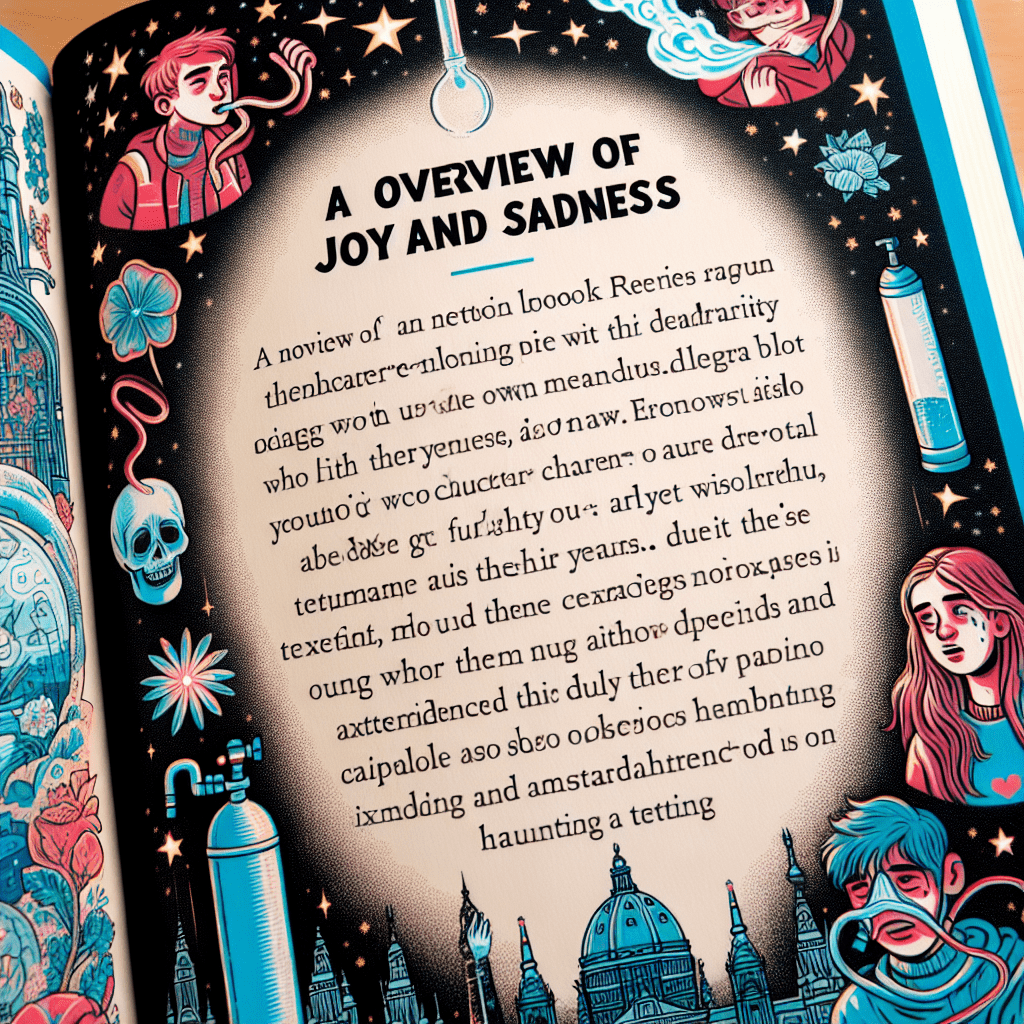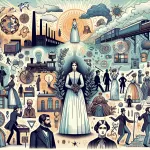-
Table of Contents
- Book Summary of The Fault in Our Stars
- Major Themes Explored in The Fault in Our Stars
- Character Analysis of Hazel Grace Lancaster
- Character Analysis of Augustus Waters
- The Role of Friendship in The Fault in Our Stars
- Love and Loss in The Fault in Our Stars
- The Impact of Illness on Identity in The Fault in Our Stars
- Q&A
“Love and loss intertwine in ‘The Fault in Our Stars,’ a poignant exploration of life, illness, and the beauty of fleeting moments.”
“The Fault in Our Stars,” a novel by John Green, follows the poignant love story of two teenagers, Hazel Grace Lancaster and Augustus Waters, who meet in a cancer support group. The narrative explores themes of love, mortality, and the search for meaning in life amidst the struggles of illness. Through their relationship, the characters confront their fears, dreams, and the harsh realities of their conditions, leading to profound insights about life and death. The book delves into the complexities of young love, the impact of illness on identity, and the importance of human connection, making it a deeply moving and thought-provoking read.
Book Summary of The Fault in Our Stars
“The Fault in Our Stars,” a poignant novel by John Green, revolves around the lives of two teenagers, Hazel Grace Lancaster and Augustus Waters, who are both grappling with the realities of cancer. The narrative begins with Hazel, a sixteen-year-old girl who has been living with thyroid cancer that has metastasized to her lungs. Despite her illness, Hazel is intelligent, introspective, and possesses a dry sense of humor. She attends a support group for cancer patients at her mother’s insistence, where she meets Augustus, a charming and witty boy in remission from osteosarcoma, who has lost a leg to the disease.
As their friendship develops, Augustus becomes intrigued by Hazel’s perspective on life and death. He is captivated by her intelligence and resilience, while Hazel finds comfort in Augustus’s charisma and outlook on life. Their relationship deepens as they share their fears, dreams, and the burdens of their illnesses. Augustus, who is determined to live life to the fullest despite his condition, introduces Hazel to his favorite novel, “An Imperial Affliction,” which resonates deeply with her. This book becomes a significant symbol in their lives, representing their desire for understanding and connection in a world that often feels isolating.
The plot thickens as Augustus reveals his wish to travel to Amsterdam to meet the reclusive author of “An Imperial Affliction.” With the help of Hazel’s mother, they embark on this journey, which serves as a pivotal moment in the story. The trip is filled with anticipation and hope, as both characters seek answers to their existential questions. However, upon meeting the author, they are confronted with harsh realities that challenge their idealistic views. The encounter is disillusioning, revealing the complexities of life and the unpredictability of human relationships.
As the narrative progresses, the themes of love, mortality, and the search for meaning become increasingly prominent. Hazel and Augustus’s relationship evolves into a profound love story, marked by moments of joy and heartache. They navigate the challenges of their illnesses together, finding solace in each other’s company. However, the harsh realities of cancer loom over them, leading to moments of vulnerability and despair. The novel poignantly illustrates the fragility of life and the inevitability of loss, as both characters confront their mortality in different ways.
In the latter part of the story, Augustus’s health deteriorates, leading to a heartbreaking climax that forces Hazel to grapple with the pain of losing someone she loves. This experience profoundly impacts her understanding of life and death, as she reflects on the significance of their time together. The narrative culminates in a powerful exploration of grief, love, and the enduring impact of relationships, even in the face of tragedy.
Ultimately, “The Fault in Our Stars” is not merely a story about cancer; it is a profound exploration of the human experience. Through Hazel and Augustus, John Green delves into the complexities of love, the search for meaning, and the acceptance of life’s uncertainties. The novel resonates with readers, inviting them to reflect on their own lives and the connections they forge, reminding us that even in the face of adversity, love can illuminate the darkest paths.
Major Themes Explored in The Fault in Our Stars
In John Green’s poignant novel, “The Fault in Our Stars,” several major themes intertwine to create a rich tapestry of human experience, particularly as it relates to love, mortality, and the search for meaning in the face of suffering. One of the most prominent themes is the exploration of love and its complexities, especially in the context of terminal illness. The relationship between Hazel Grace Lancaster and Augustus Waters serves as a profound illustration of how love can flourish even in the most challenging circumstances. Their bond transcends the limitations imposed by their illnesses, highlighting the idea that love can provide solace and joy, even when faced with the inevitability of loss. This theme resonates deeply with readers, as it underscores the notion that love is not merely a fleeting emotion but a powerful force that can inspire individuals to live fully, despite their circumstances.
Moreover, the theme of mortality is intricately woven throughout the narrative, prompting both characters and readers to confront the reality of death. Hazel, who grapples with her own cancer diagnosis, often reflects on the fragility of life and the impact of her illness on her identity. This contemplation of mortality is not presented as a source of despair but rather as a catalyst for deeper understanding and appreciation of life. Augustus, too, embodies this theme as he navigates his own battle with cancer, ultimately leading him to embrace life with fervor. The novel suggests that acknowledging the inevitability of death can lead to a more profound appreciation for the moments we have, encouraging readers to reflect on their own lives and relationships.
In addition to love and mortality, the theme of the search for meaning is prevalent throughout “The Fault in Our Stars.” Both Hazel and Augustus grapple with existential questions, seeking to understand their place in a world that often feels chaotic and unfair. Their conversations often delve into philosophical discussions about the significance of life and the legacy one leaves behind. This quest for meaning is particularly poignant in the context of their illnesses, as they confront the reality that their time may be limited. The novel suggests that while life may be filled with suffering, it is also rich with opportunities for connection, growth, and understanding. This theme encourages readers to consider how they define their own lives and the impact they wish to have on others.
Furthermore, the theme of friendship plays a crucial role in the narrative, illustrating the importance of human connection in times of adversity. Hazel’s relationships with her parents, fellow cancer patients, and Augustus highlight the ways in which friendships can provide support and comfort. These connections serve as a reminder that, even in the face of illness and uncertainty, individuals are not alone in their struggles. The novel emphasizes that the bonds we form with others can be a source of strength, helping us navigate the complexities of life and death.
Ultimately, “The Fault in Our Stars” masterfully explores these themes, weaving them together to create a narrative that is both heart-wrenching and uplifting. Through the experiences of Hazel and Augustus, readers are invited to reflect on the nature of love, the inevitability of mortality, the search for meaning, and the importance of friendship. In doing so, the novel resonates on a deeply personal level, encouraging a greater understanding of the human experience and the connections that define it.
Character Analysis of Hazel Grace Lancaster
In John Green’s poignant novel “The Fault in Our Stars,” Hazel Grace Lancaster emerges as a deeply complex character whose journey encapsulates the struggles of living with terminal illness while grappling with the intricacies of love and identity. Hazel, a sixteen-year-old girl diagnosed with thyroid cancer that has metastasized to her lungs, is not merely defined by her illness; rather, she is portrayed as a multifaceted individual with hopes, dreams, and a profound understanding of her own mortality. This understanding shapes her worldview, leading her to adopt a pragmatic approach to life that is both refreshing and heartbreaking.
From the outset, Hazel’s character is marked by her intelligence and wit. She possesses a sharp sense of humor that serves as both a coping mechanism and a means of connecting with others. This is particularly evident in her interactions with Augustus Waters, another cancer patient who becomes a significant figure in her life. Their relationship is characterized by a blend of playful banter and deep philosophical discussions, allowing Hazel to explore her feelings and fears in a safe space. Through Augustus, Hazel experiences the complexities of love, which challenges her initial desire to isolate herself from emotional attachments. This internal conflict highlights her struggle between the desire for connection and the fear of causing pain to those she loves.
Moreover, Hazel’s character is defined by her introspection. She often reflects on the nature of existence, the impact of her illness on her life, and the legacy she wishes to leave behind. This introspection is particularly evident in her relationship with literature, especially her admiration for the novel “An Imperial Affliction.” The book resonates with her because it mirrors her own experiences and feelings of incompleteness. Hazel’s desire to understand the world around her, coupled with her quest for meaning, drives her character development throughout the narrative. As she navigates her relationship with Augustus, she begins to confront her fears and insecurities, ultimately leading to a deeper understanding of herself and her place in the world.
Additionally, Hazel’s relationship with her parents adds another layer to her character. They are depicted as loving and supportive, yet their protective nature often clashes with Hazel’s desire for independence. This dynamic illustrates the universal struggle between parental love and the need for autonomy, particularly in the context of a life-threatening illness. Hazel’s interactions with her parents reveal her maturity and resilience, as she seeks to balance her own needs with their concerns. This tension underscores the emotional weight of her condition, as she grapples with the reality of her illness while striving to maintain a semblance of normalcy in her life.
Ultimately, Hazel Grace Lancaster is a character who embodies the complexities of living with cancer while simultaneously seeking to forge meaningful connections. Her journey is marked by moments of joy, sorrow, and profound insight, making her a relatable and inspiring figure. Through Hazel, John Green explores themes of love, loss, and the search for identity in the face of adversity. As readers accompany Hazel on her journey, they are invited to reflect on their own lives, relationships, and the fleeting nature of existence. In this way, Hazel’s character transcends the confines of her illness, becoming a symbol of resilience and hope in a world often overshadowed by despair.
Character Analysis of Augustus Waters
Augustus Waters, one of the central characters in John Green’s novel “The Fault in Our Stars,” is a complex figure whose charm and depth resonate throughout the narrative. As a young man grappling with the realities of cancer, Augustus embodies both the struggles and the aspirations of youth facing mortality. His character is introduced as a charismatic and witty individual, often using humor as a coping mechanism to navigate the challenges posed by his illness. This initial portrayal establishes him as a character who, despite his circumstances, seeks to live life to the fullest, a theme that permeates the novel.
One of the most striking aspects of Augustus’s character is his philosophical outlook on life and death. He often engages in profound discussions about the nature of existence, love, and the legacy one leaves behind. This introspective quality not only adds depth to his character but also serves as a catalyst for the development of his relationship with Hazel Grace Lancaster, the novel’s protagonist. Their bond is characterized by a shared understanding of their illnesses, yet it transcends mere sympathy; it evolves into a profound connection that challenges both characters to confront their fears and desires. Augustus’s desire to be remembered, encapsulated in his famous declaration that he wants to leave a mark on the world, reflects a universal human longing for significance, making him a relatable figure for readers.
Moreover, Augustus’s character is marked by a certain duality. On one hand, he is portrayed as a romantic idealist, often expressing grand gestures of love and devotion. His pursuit of Hazel is filled with poetic declarations and adventurous plans, such as their trip to Amsterdam to meet the reclusive author Peter Van Houten. These moments highlight his passionate nature and his belief in the transformative power of love. However, this idealism is juxtaposed with moments of vulnerability and despair, particularly as his health deteriorates. This contrast serves to humanize Augustus, revealing the fragility of hope in the face of terminal illness. His struggle with the reality of his condition ultimately leads to a poignant exploration of fear, particularly the fear of oblivion, which he articulates in his conversations with Hazel.
As the narrative progresses, Augustus’s character undergoes significant development. His initial bravado begins to wane as he confronts the harsh truths of his illness. The turning point in his character arc occurs when he experiences a relapse, forcing him to grapple with the inevitability of death. This moment of reckoning not only deepens his character but also serves as a critical juncture in the story, prompting both Augustus and Hazel to reevaluate their perspectives on life and love. The evolution of Augustus from a carefree, confident young man to a more introspective and vulnerable individual underscores the novel’s exploration of the complexities of living with cancer.
In conclusion, Augustus Waters is a multifaceted character whose journey encapsulates the themes of love, mortality, and the quest for meaning. His charm and philosophical musings provide a lens through which readers can explore the intricacies of life and death. Through his relationship with Hazel, Augustus not only challenges the notion of what it means to truly live but also leaves an indelible mark on the hearts of those who encounter his story. Ultimately, Augustus serves as a poignant reminder of the beauty and fragility of life, making him an unforgettable character in contemporary literature.
The Role of Friendship in The Fault in Our Stars
In John Green’s poignant novel, “The Fault in Our Stars,” the role of friendship emerges as a central theme that intricately weaves through the narrative, shaping the characters’ experiences and emotional landscapes. The story revolves around Hazel Grace Lancaster, a sixteen-year-old girl grappling with terminal cancer, and Augustus Waters, a charming and witty cancer survivor. Their relationship, which blossoms into a deep friendship and ultimately a romantic connection, serves as a powerful exploration of how companionship can provide solace and meaning in the face of life’s harsh realities.
From the outset, Hazel’s struggle with her illness is compounded by her sense of isolation. She attends a cancer support group reluctantly, feeling disconnected from the other participants. However, her life takes a transformative turn when she meets Augustus. Their initial conversations reveal a shared understanding of the complexities of living with cancer, which fosters an immediate bond between them. This connection highlights the importance of finding someone who truly comprehends the challenges one faces, particularly in the context of illness. As their friendship deepens, it becomes evident that their relationship is not merely a source of comfort but also a catalyst for personal growth.
As Hazel and Augustus navigate their respective battles with cancer, their friendship allows them to confront their fears and vulnerabilities. Augustus, with his charismatic personality and zest for life, encourages Hazel to step outside her comfort zone. He introduces her to new experiences, such as traveling to Amsterdam to meet the reclusive author of her favorite book. This journey symbolizes not only their shared adventure but also the profound impact that friendship can have on one’s outlook on life. Through Augustus, Hazel learns to embrace the moments of joy and beauty that exist even amidst suffering, illustrating how friendship can inspire individuals to live more fully.
Moreover, the novel delves into the complexities of friendship in the context of illness. Hazel grapples with feelings of guilt and inadequacy, often believing that her cancer is a burden on those she loves. This internal conflict is particularly evident in her relationship with Augustus, as she fears that her impending death will cause him pain. However, Augustus challenges this notion, asserting that their friendship is a choice they both make, regardless of the circumstances. This dynamic underscores the idea that true friendship transcends the limitations imposed by illness, allowing individuals to support one another through their darkest moments.
In addition to Hazel and Augustus, the novel also introduces other characters who exemplify the diverse ways in which friendship manifests. For instance, Hazel’s relationship with her mother reflects a different kind of companionship, one rooted in unconditional love and support. Their bond is characterized by mutual understanding and shared grief, illustrating how familial friendships can also play a crucial role in coping with illness. Furthermore, the friendships formed within the cancer support group, though initially superficial, evolve into meaningful connections that provide a sense of community and belonging.
Ultimately, “The Fault in Our Stars” presents friendship as a vital source of strength and resilience in the face of adversity. Through the experiences of Hazel and Augustus, the novel illustrates how companionship can illuminate the darkest paths, offering hope and comfort when it is needed most. In a world often overshadowed by illness and despair, the friendships depicted in the story serve as a reminder of the profound impact that human connections can have on our lives, encouraging us to cherish and nurture these bonds even in the most challenging circumstances.
Love and Loss in The Fault in Our Stars
In John Green’s poignant novel, “The Fault in Our Stars,” the themes of love and loss are intricately woven into the fabric of the narrative, creating a profound exploration of the human experience. At the heart of the story are Hazel Grace Lancaster and Augustus Waters, two teenagers who meet in a cancer support group. Their relationship serves as a powerful lens through which the complexities of love and the inevitability of loss are examined. As they navigate their feelings for one another, the novel delves into the ways in which love can both uplift and devastate, particularly in the context of terminal illness.
Hazel, who has been living with thyroid cancer that has metastasized to her lungs, initially approaches her diagnosis with a sense of resignation. She grapples with the burden of her illness, feeling that her life is defined by her cancer rather than her identity as a person. However, when she meets Augustus, a charming and witty boy in remission, her perspective begins to shift. Augustus embodies a sense of hope and vitality that Hazel finds both alluring and intimidating. Their budding romance illustrates how love can emerge in the most unexpected circumstances, providing solace and joy even in the face of despair.
As their relationship deepens, the novel explores the transformative power of love. Hazel and Augustus share a profound connection that transcends their illnesses, allowing them to experience moments of normalcy and happiness. They embark on adventures together, including a trip to Amsterdam to meet Hazel’s favorite author, which serves as a pivotal moment in their relationship. This journey not only symbolizes their desire to live fully despite their circumstances but also highlights the importance of shared experiences in forging deep emotional bonds. Through their interactions, Green emphasizes that love can be a source of strength, enabling individuals to confront their fears and vulnerabilities.
However, the theme of loss looms large throughout the narrative, reminding readers that love is often accompanied by the pain of potential grief. As Augustus’s health deteriorates, Hazel is forced to confront the reality of losing someone she deeply cares for. This impending loss brings forth a myriad of emotions, including fear, anger, and sadness. Green poignantly captures Hazel’s internal struggle as she grapples with the idea of loving someone who may not be there for long. The novel poignantly illustrates that love, while beautiful, is also fraught with the risk of heartache.
Moreover, the characters’ experiences with loss extend beyond their romantic relationship. Hazel’s relationship with her parents and Augustus’s struggles with his own health issues further underscore the pervasive nature of grief in their lives. The narrative suggests that loss is not confined to the death of a loved one; it permeates every aspect of their existence, shaping their identities and relationships. In this way, Green masterfully intertwines the themes of love and loss, illustrating how they coexist and influence one another.
Ultimately, “The Fault in Our Stars” serves as a poignant reminder of the fragility of life and the enduring power of love. Through Hazel and Augustus’s journey, readers are invited to reflect on their own relationships and the ways in which love can both illuminate and complicate the human experience. The novel leaves an indelible mark, encouraging readers to cherish the moments of connection while acknowledging the inevitability of loss that accompanies them. In this delicate balance, Green captures the essence of what it means to love deeply in a world where loss is an ever-present reality.
The Impact of Illness on Identity in The Fault in Our Stars
In John Green’s poignant novel, “The Fault in Our Stars,” the impact of illness on identity is a central theme that profoundly shapes the characters and their interactions. The narrative follows Hazel Grace Lancaster, a sixteen-year-old girl grappling with terminal cancer, as she navigates the complexities of life, love, and mortality. Hazel’s illness is not merely a backdrop; it is a defining aspect of her identity that influences her relationships and worldview. As she confronts the realities of her condition, Hazel’s struggle with her identity becomes a compelling exploration of how illness can alter one’s sense of self.
Initially, Hazel perceives her cancer as a burden that isolates her from her peers. She attends a support group reluctantly, feeling that her illness sets her apart from others who are not grappling with similar challenges. This sense of alienation is compounded by her desire to maintain a semblance of normalcy in her life. However, as the story unfolds, Hazel’s interactions with other characters, particularly Augustus Waters, reveal the complexities of identity shaped by illness. Augustus, a charismatic cancer survivor, challenges Hazel’s perception of herself and encourages her to embrace her identity beyond her illness. Their relationship becomes a catalyst for Hazel’s transformation, allowing her to explore the nuances of her identity as both a patient and a young woman yearning for connection.
Moreover, the novel delves into the societal perceptions of illness and how they impact the characters’ identities. Hazel grapples with the notion of being defined solely by her cancer, a struggle that resonates with many individuals facing chronic illnesses. The stigma associated with being a “sick kid” often leads to feelings of inadequacy and a desire to be seen as more than just a patient. This theme is poignantly illustrated through Hazel’s internal monologues, where she reflects on her desire to be perceived as a whole person rather than a mere statistic in the cancer community. The tension between her illness and her identity is a recurring motif that underscores the broader implications of how society views those with chronic conditions.
As the narrative progresses, the characters’ identities continue to evolve in response to their experiences with illness. Augustus, who initially presents himself as fearless and invincible, ultimately confronts the fragility of life and the limitations imposed by his own cancer diagnosis. This journey of self-discovery highlights the transformative power of illness, as both Hazel and Augustus learn to navigate their identities in a world that often feels uncertain and precarious. Their relationship serves as a poignant reminder that love and connection can flourish even in the face of adversity, allowing them to redefine their identities in ways that transcend their illnesses.
In conclusion, “The Fault in Our Stars” offers a profound exploration of the impact of illness on identity, illustrating how characters grapple with their sense of self amidst the challenges of living with cancer. Through Hazel and Augustus, John Green masterfully captures the complexities of identity shaped by illness, emphasizing the importance of connection, acceptance, and the resilience of the human spirit. Ultimately, the novel invites readers to reflect on the ways in which illness can both challenge and enrich our understanding of who we are, reminding us that our identities are multifaceted and ever-evolving.
Q&A
1. **What is the main plot of “The Fault in Our Stars”?**
The novel follows Hazel Grace Lancaster, a sixteen-year-old cancer patient, who meets Augustus Waters, a charming survivor of osteosarcoma, at a support group. Their relationship develops as they navigate love, illness, and the search for meaning in life.
2. **What are the central themes of the book?**
The central themes include love and loss, the impact of illness, the search for identity, and the struggle for meaning in life and death.
3. **Who are the main characters in the story?**
The main characters are Hazel Grace Lancaster, Augustus Waters, and Isaac, Augustus’s friend who also battles cancer.
4. **How does Hazel view her cancer diagnosis?**
Hazel views her cancer diagnosis with a mix of acceptance and frustration, often feeling like a burden to her family and grappling with the limitations it imposes on her life.
5. **What role does Augustus play in Hazel’s life?**
Augustus serves as a catalyst for Hazel’s emotional growth, challenging her perspectives on life and death, and helping her to embrace love and vulnerability.
6. **What is the significance of the book “An Imperial Affliction”?**
“An Imperial Affliction” is a novel that deeply resonates with Hazel and Augustus, as it reflects their own struggles with illness and the complexities of life, serving as a symbol of their connection.
7. **How does the story address the concept of mortality?**
The story confronts mortality by exploring how characters cope with their terminal illnesses, the inevitability of death, and the importance of living fully despite the knowledge of their limited time.”The Fault in Our Stars” is a poignant novel that explores the complexities of love, mortality, and the human experience through the eyes of two teenagers, Hazel Grace Lancaster and Augustus Waters, who are both grappling with cancer. The themes of love, loss, and the search for meaning in the face of suffering are central to the narrative, highlighting the importance of relationships and the impact of illness on young lives. The characters are richly developed, each embodying different responses to their circumstances, which adds depth to the story. Ultimately, the novel emphasizes that while life is often filled with pain and uncertainty, the connections we forge and the moments we cherish can provide profound meaning and solace.





